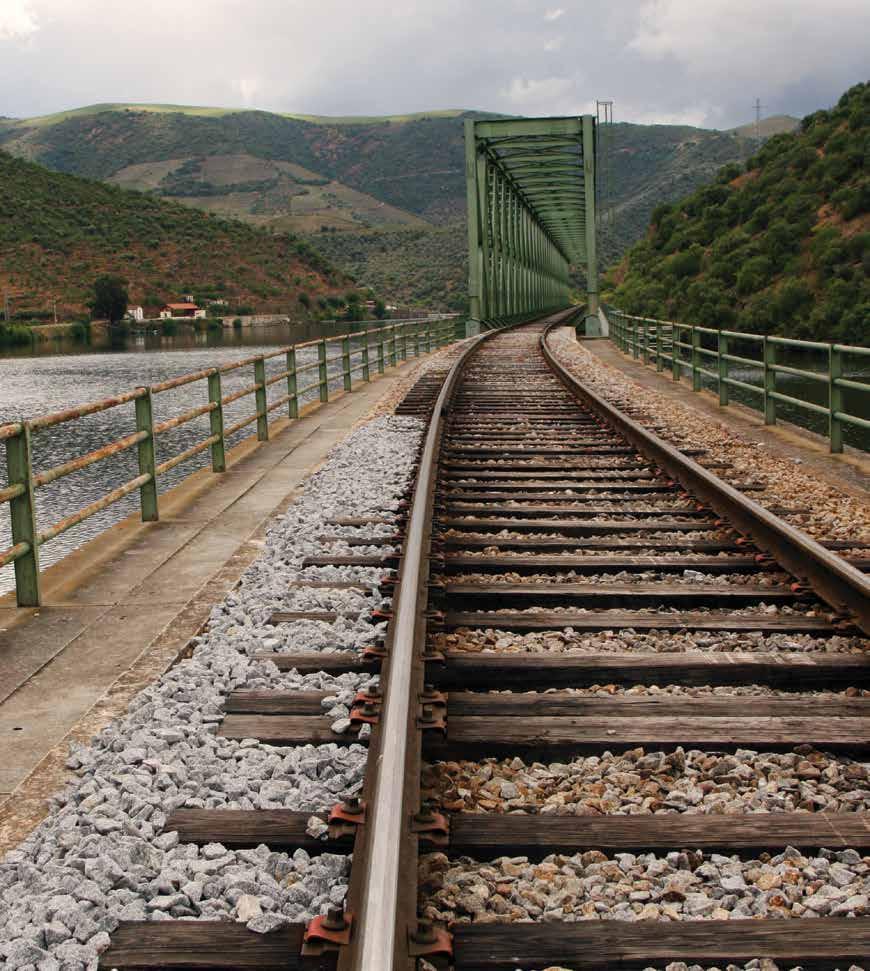
33 minute read
Fio-de-Prumo
Plumb Line Fio-de-Prumo32 Fio-de-Prumo Plumb Line
Ferrovia Railways A toda a velocidade Full steam ahead
Advertisement
O ministro das Infraestruturas e da Habitação tem mostrado ser um verdadeiro guarda-freio dos caminhos ferroviários do País. Quer parecer que a agulha está apontada para o carril certo. Mau grado, a carruagem do desenvolvimento da ferrovia nem sempre conseguiu cumprir horários. The Infrastructure and Housing Minister has proven to be a true champion for Portugal’s railways. The turnout seems like it’s pointed at the right track. Despite this, the railway development carriage hasn’t always been able to keep to the schedule.
Os comboios sempre encurtaram distâncias, aproximaram comunidades e economias. Impediram o isolamento. Além disso, sempre houve, e haverá, algo de romântico nas viagens sob os carris da nossa terra. Apesar desta realidade, os últimos governos portugueses foram mais apologistas da rodovia do que da ferrovia. Com isso, assistiu-se, sobretudo no interior, ao encerramento de estações, ao crescer da relva por entre os carrilhos e algumas populações tiveram de deslocar-se ou dar uma volta maior para chegar aos empregos, aos hospitais, às escolas… No litoral a vida também não ficou mais fácil. Os comboios, com frequência, encontram-se sobrelotados e atrasados. Aliás, como o próprio ministro das Infra-estruturas e da Habitação, Pedro Nuno Santos, afirmou, aquando da apresentação do Programa Nacional de Investimentos 2030 (PNI 2030): “Portugal achou que a ferrovia era um investimento do passado”, com “sucessivos governos a fazer aposta quase exclusiva na rodovia”. Mas, como salientou, a ferrovia é hoje “uma prioridade europeia”, sublinhando as “mais-valias do ponto de vista ambiental”. Refira-se que, no âmbito do PNI 2030, foi anunciado que os transportes e a mobilidade vão poder contar com uma verba de 21600 milhões de euros, sendo que à ferrovia vai caber a maior fatia deste investimento.
Encurtar distâncias
No próximo Orçamento de Estado de 2021 a aposta vai passar pelo transporte de passageiros, pela electrificação de toda a rede ferroviária e pela resolução de estrangulamentos à mobilidade das Áreas Metropolitanas de Lisboa e Porto. Neste último ponto, está previsto a quadruplicação de vias. O argumento prende-se com a intenção de reduzir drasticamente o número, que chega aos milhares, de automóveis que circulam diariamente nas estradas destas duas áreas e, com isso, melhorar a qualidade de vida e ambiental dos seus habitantes. Encurtar as distâncias parece ser o mote, pelo que o Governo recuperou uma aspiração antiga que, outrora, já dividiu partidos com assento parlamentar mas que, agora, parece reunir algum consenso político: as linhas de comboio de alta velocidade. A começar pela nova linha prevista para a ligação Porto-Lisboa que, por um lado, colocará as duas áreas metropolitanas a cerca de uma hora de viagem e, por outro, reduzirá a viagem entre Lisboa e Leiria, que passa de quatro horas para 30 minutos, e entre Coimbra e o Porto, que passa para 30 minutos. A ligação Porto-Vigo também está em cima da mesa. Agora, esta viagem tem a duração de 2h30m mas após concretizar-se o novo troço previsto para Braga-Vigo ambas as ci-
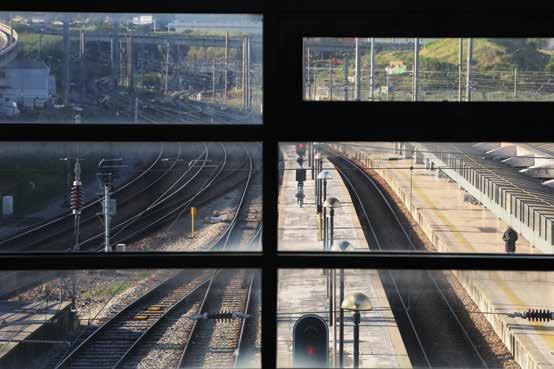
dades vão ficar à distância de apenas 35 minutos, ou seja, a viagem vai demorar menos uma hora do que actualmente. Embora o comboio de alta velocidade esteja longe de reunir o consenso nacional, estas duas ligações encontram-se inscritas no novo PNI e deverão avançar até 2030. Depois da Infraestruturas de Portugal (IP) ter lançado o concurso para a requalificação da Linha do Oeste entre Torres Vedras e Caldas da Rainha, no distrito de Leiria, agora é a vez da modernização entre Mira Sintra-Meleças e Torres Vedras. Para quem desconhece, trata-se de uma ligação que muito raramente conseguia cumprir horários, tinha frequentemente avarias e era servida por uma automotora completamente desactualizada mas que era utilizada por muitos utentes na ligação de Lisboa a Sintra pelo facto de ser um comboio que não pára em todas as estações deste percurso e com isso encurta a viagem. Esta intervenção faz parte do programa Ferrovia 2020 que prevê a electrificação integral do troço, a beneficiação de cinco estações e seis apeadeiros e a criação e melhoria dos acessos às plataformas de passageiros para pessoas com mobilidade condicionada. Mas a bem da verdade, a esmagadora maioria dos projectos traçados ao abrigo deste programa não ficaram concluídos até ao final de 2020 e tudo leva a crer que deverão resvalar até 2023.
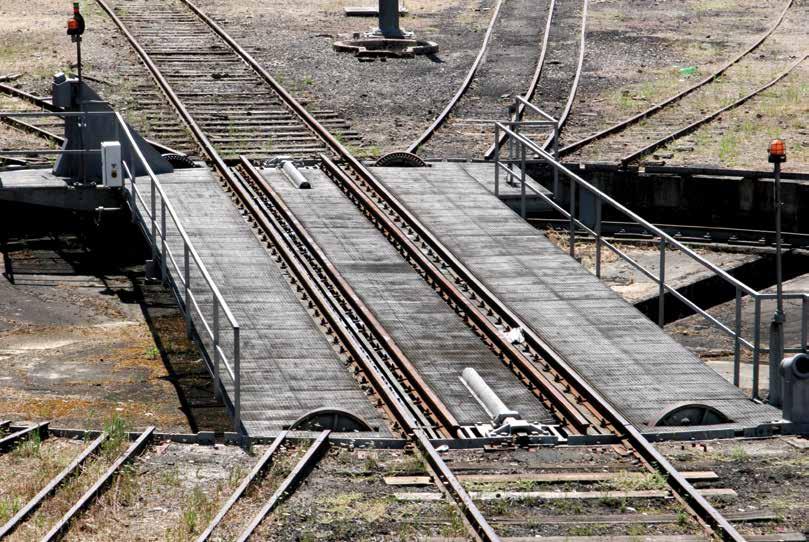
Ambição made in Portugal
A aquisição de material circulante é outra das prioridades do actual Executivo. A informação oficial avança com a compra de 129 novos comboios, dos quais 62 são urbanos, 55 regionais e 12 longo curso. Recorde-se, no entanto, que no dia 15 de Janeiro de 2020 foi inaugurada a oficina de Guifões, em Matosinhos, com o objectivo de Portugal achou que a ferrovia era um investimento do passado (…) mas a ferrovia é hoje uma prioridade europeia. Portugal has believed railways were an investment of the past (…) but the rail is now a European priority.”
recuperar carruagens para voltarem a ser novamente utilizadas. “Do velho se faz novo”. As primeiras carruagens vão ser utilizadas na inauguração da electrificação da Linha do Minho e, embora a prioridade da sua utilização seja nos serviços InterRegionais e Regionais desta linha, não está excluída a sua utilização no reforço de outros serviços Regionais ou de Longo Curso (Intercidades). Mas a grande aspiração para este “centro tecnológico ferroviário”, na designação de Pedro Nuno Santos, é, pois, fazer comboios novos em Portugal em vez de os adquirir no estrangeiro. Aliás, segundo o secretário de Estado das Infra-estruturas o Governo encontra-se a preparar um concurso para aquisição de mais 100 composições para a CP, a realizar em Março, que irá “privilegiar os candidatos que queiram construir em Portugal”. A este propósito, em declarações à Lusa, o presidente da CP, Nuno Freitas, afirmou que “o desafio é trazer uma fábrica de comboios para Portugal”.
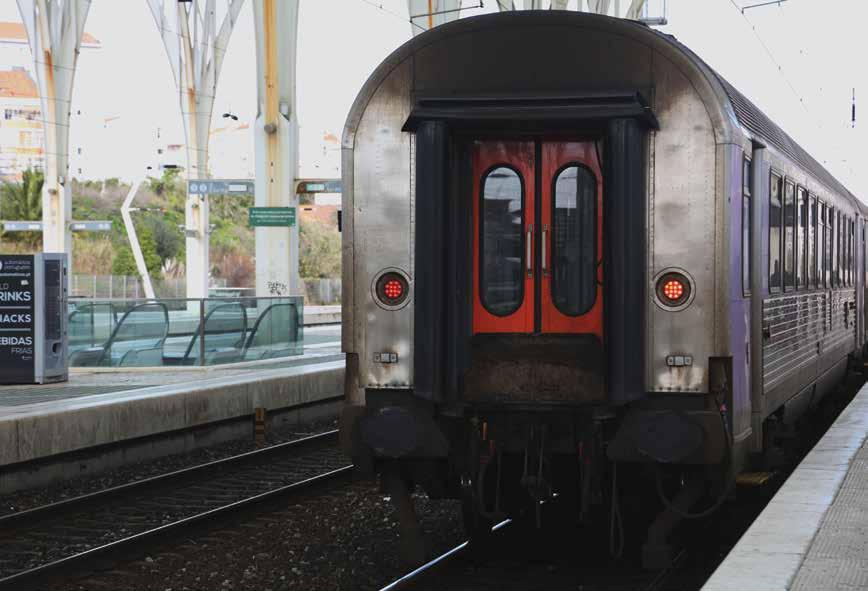
Trains have always shortened distances and brought communities and economies closer together. They have prevented isolation. In addition, there has always been – and always will be – something romantic about trips on Portugal’s rails. Despite this, the country’s governments in recent years have been apologists more for our motorways than our railways. Because of this, we have seen stations close (especially in inland Portugal), grass grow between the rails, and some people have to move or take a longer way to get to work, hospitals, schools… Life on the coastline hasn’t gotten much easier either. Trains are frequently overcrowded and behind schedule. In fact, Infrastructure and Housing Minister Pedro Nuno Santos even said himself during the presentation of the2030 National Investment Programme (PNI 2030) that “Portugal has believed railways were an investment of the past,” with “successive governments prioritising roadways almost exclusively.” But, he explains, rail is now “a European priority,” with emphasis placed on its “environmental advantages.” In the framework of the PNI 2030, it was announced that the transportation and mobility budget will be €21.6 billion EUR, and rail will receive the largest share of this investment.
Foi anunciado que os transportes e a mobilidade vão poder contar com uma verba de 21600 milhões de euros, sendo que à ferrovia vai caber a maior fatia deste investimento. It was announced that the transportation and mobility budget will be €21.6 billion EUR, and rail will receive the largest share of this investment.”
Shortening distances
In the 2021 State Budget, the focus will be on passenger transport, electrifying the entire railway network, and solving bottlenecks in Lisbon’s and Porto’s transportation networks. To tackle this last point, the number of lanes is planned to quadruple. It is hoped that this will help drastically reduce the number of cars that use these two areas’ motorways(which reaches the thousands on a daily basis) and thereby improve the environment and the quality of life for the cities’ inhabitants. Shortening distances seems to be the goal, so the Government has taken back up an old aspiration that, in the past, divided parties with parliamentary seats but which now seems to attract some political consensus: high-speed train lines. Let’s begin with the new line that is planned to link Porto with Lisbon. A trip between these two metropolitan areas will be about an hour each way. Getting to Leiria from Lisbon will go from a four-hour trip to 30 minutes, and Coimbra and Porto will also be only about half an hour from each other. A line linking Porto and Vigo is also on the table. Currently, this trip takes 2h30m, but, after the section of rail planned between Braga and Vigo is built, both cities will be only about 35 minutes from each other. In other words, the trip will take an hour less than it does currently. Although high speed rail is far from garnering national consensus, these two connections are found in the new PNI and should move forward by 2030. After Portugal’s Infrastructure Agency (IP) launched the tender for the West Line rebuild between Torres Vedras and Caldas da Rainha in the district of Leiria, it is now time to modernise the line between Mira Sintra-Meleças and Torres Vedras. For those unfamiliar with this part of the rail network, trains along this line rarely arrive on schedule, faults and breakdowns are frequent, and it is served by railcars that are woefully outdated – despite being used by many riders going from Lisbon to Sintra due to the fact thatthis train doesn’t stop at all stations on this route, thereby shortening the travel time. This project is part of the Railway 2020 programme which provides for the electrification of the entire section, improvements at five main stations and six smaller stops, and improvements to passenger platform access
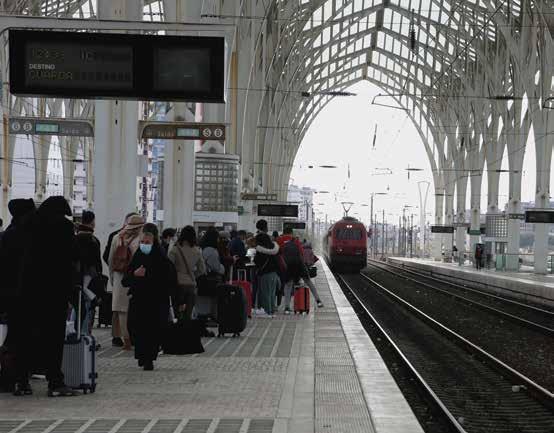
for people with disabilities. But, in reality, the overwhelming majority of this programme’s projects were not finished by the end of 2020, and it looks like things might slip into 2023 before they are done.
Made in Portugal
Acquiring rolling stock is another priority for the current Executive Branch. Official information states that 129 new trains will be purchased, 62of which will be destined for urban lines, 55 for regional lines, and 12 for long-distance lines. Remember that the Guifões workshop was inaugurated in Matosinhos on 15 January 2020; its goal is to refurbish carriages so that they can be used again. “Making new from the old,” as they say. The first carriages will be used on the Minho Line once it is electrified, and, although the priority is to use them for this line’s InterRegional and Regional services, they could also be used on other Regional or LongDistance (Intercidades) services. For Santos, the great hope is for this “railway tech centre” to eventually produce new trains that are made in Portugal instead of purchasing them from abroad. In fact, the State’s Infrastructure Secretary says that the Government is preparing a 100-unit tender for Trains of Portugal (CP). This tender will be held in March and will “prioritise candidates who want to build in Portugal.” Speaking on this topic, CP President Nuno Freitas told Lusa that “the challenge is to bring a train factory to Portugal.”

O desafio é trazer uma fábrica de comboios para Portugal. The challenge is to bring a train factory to Portugal.”
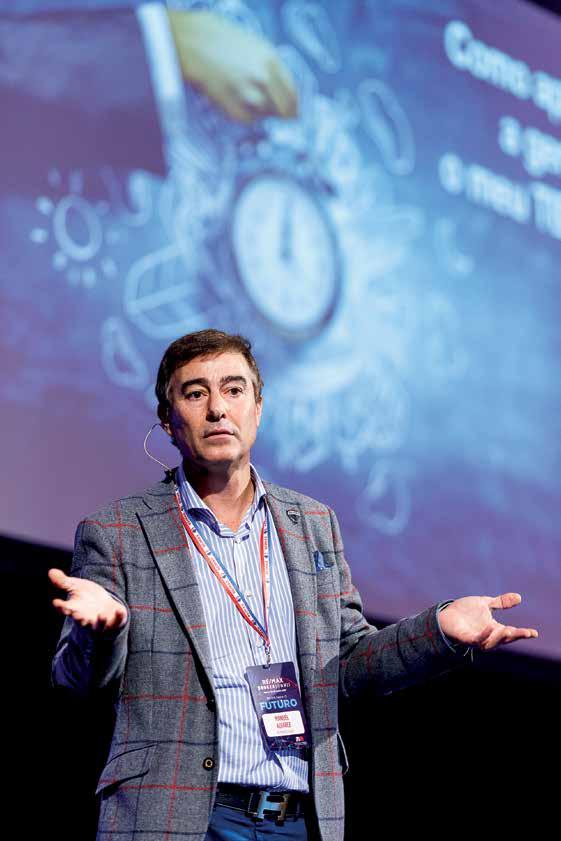
Coordinates Azimute40 Azimute Coordinates
Habitação Housing Continuamos a ser pobres We’re still poor

No parque habitacional português gasta-se muita energia, poupase pouca e está longe de ser eficiente. Mas alguns portugueses já começaram a meter a “mão na massa” para reverter esta realidade. Portuguese homes, by and large, waste lots of energy, save little, and are often rather inefficient. Some in our country, though, have begun working on disrupting this reality.
Quando o Novo Regime do Arrendamento Urbano (NRAU) foi criado em 2006 fazia antever uma corrida às obras nos edifícios com os olhos postos na actualização (aumento) das rendas. Muito se fez de lá para cá, na construção nova e na reabilitação, embora, a bem da verdade, em muitos casos, o parque habitacional tenha apenas recebido um lifting. As mudanças climáticas e os termómetros revelaram também as dificuldades de adaptação das casas às variações térmicas, sobretudo nas mais antigas. O mês de Julho, de acordo com o Instituto Português do Mar e da Atmosfera (IPMA), foi o mais quente em Portugal dos últimos 89 anos e o mês de Outubro foi o mais frio dos últimos 17 anos. Nos lares portugueses ora se abrem janelas para ventilar, ora se bate o dente de frio e acendem-se lareiras e aquecedores porque as casas não estão preparadas nem para Invernos mais rigorosos, nem para Verões mais quentes e secos. Os dados do gabinete estatístico europeu Eurostat corroboram esta realidade: Mais de 15% da população da União Europeia (UE) vive em condições inadequadas de habitação; Portugal encontra-se abaixo da média europeia no que toca a eficiência energética em edifícios; e aproximadamente 75% do parque imobiliário da UE é ineficiente a nível energético, ou seja, grande parte da energia consumida é desperdiçada. Algumas das mais relevantes ameaças à saúde que podem ser encontradas nas habitações, segundo o Eurostat, vão desde a qualidade do ar interno ser insuficiente, ruído, humidade e crescimento de mofo, temperaturas internas inadequadas e falta de equipamentos. Esta realidade torna-se mais notória nas famílias de baixo rendimento com filhos e em estado de pobreza. E, como se sabe, a habitação inadequada insere-se num círculo vicioso que aumenta o risco de pobreza e exclusão social. Num País que pretende cumprir as metas ambientais traçadas pela UE urge reverter este cenário. Foi assim que o Governo lançou, em Setembro, o “Programa de Apoio Edifícios Sustentáveis” para os cidadãos particulares proprietários de fracções ou edifícios de habitação, construídos até ao final de 2006. Desenvolvido no âmbito do Fundo Ambiental, disponibiliza uma verba de 4,5 milhões euros, sendo que 1,75 milhões de euros vão ser atribuídos em 2020 e 2,75 milhões de euros em 2021. Esta iniciativa, que conta com o
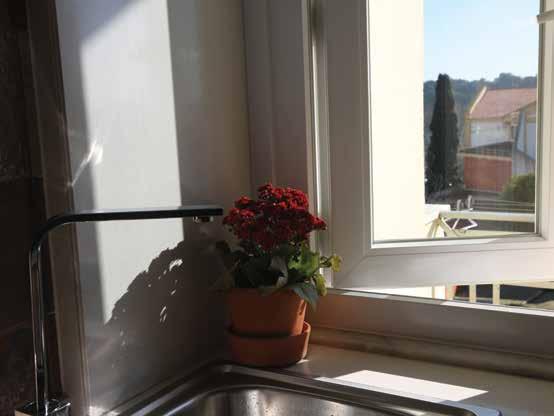
apoio técnico da ADENE – Agência para Energia, tem por objectivo promover intervenções que visem a reabilitação, descarbonização, eficiência energética, eficiência hídrica e economia circular em edifícios.

O que procuram os portugueses?
O ministro do Ambiente e da Acção Climática, João Pedro Matos Fernandes, afirmou que processo como o do Programa de Apoio Edifícios Sustentáveis “mais simples não há”. E explicou como: “Faça-se a obra, envie-se a factura e a prova de que se é titular da casa, e recebe-se o dinheiro”. Mas advertiu, claro, que “haverá inspecções” para verificar se as obras foram realmente concretizadas. Cerca de dois meses depois de ter sido lançado, o ministério do Ambiente anunciava que já tinha atribuído um milhão de euros em pagamentos para tornar os edifícios mais eficientes. Desde 7 de Setembro, data em que abriram as candidaturas na plataforma do Fundo Ambiental, foram submetidos 4.234 formulários, dos quais já foram pagas 890 candidaturas, a que correspondem 1,75 milhões de euros. O programa foi encerrado no final de Dezembro mas o Executivo já garantiu que as candidaturas vão ser reabertas em Março de 2021, com montantes do Plano de Recuperação e Resiliência. Com um valor médio do incentivo atribuído por candidatura de 1.900 euros, os portugueses recorreram a este apoio, sobretudo, para instalar painéis fotovoltaicos (50%), bombas de calor e painéis solares (38%) e janelas eficientes (10%). João Pedro Matos Fernandes salientou que em Portugal “existe pobreza energética e muitos edifícios estão muito longe dos padrões de eficiência energética significativa”, defendendo que através deste programa será possível reduzir o gasto em energia. Como sublinhou: “A energia mais barata é a que não se gasta”.
Falta visão de longo prazo
Apesar da eficiência energética ter sido integrada no Fundo Ambiental, a par dos novos programas e verbas de apoio, a realidade é que continua a não existir uma estratégia de longo prazo em matéria de combate à pobreza energética. Aliás, recorde-se que já foi emitida uma Recomendação Europeia 2020/1563 para todos os Estados-membros relativa à implementação da Directiva 2019/944 que entra em vigor no dia 1 de Janeiro de 2021 e cujo artigo 29º
Fora da caixa
Out of the box
O melhor de 2020 The best of 2020
Num ano atípico a associação ZERO identificou alguns factos positivos de 2020: • Demonstração que os cidadãos estão disponíveis para a transição para a sustentabilidade investindo na melhoria da eficiência energética, tal como ficou expresso na sua adesão ao Programa de Apoio a Edifícios Mais Sustentáveis do Fundo Ambiental; • Aumento muito significativo da procura de bicicletas no seguimento da disponibilização de incentivos a soluções de mobilidade suave por parte de algumas autarquias; • Experiência resultante da paragem da economia mundial que permitiu vivenciar uma qualidade ambiental como há décadas não era possível; • E persistência da União Europeia na sua visão assente na sustentabilidade, não obstante todas as pressões para atrasar a transição para um modelo de desenvolvimento circular e centrado na promoção do bem-estar de todos.
During an atypical year, environmental association ZERO identified some positive things about 2020: • Signals that citizens are ready to transition into a sustainability-focused mindset by investing in improvements to energy efficiency, made manifest by their accession to the Environmental Fund’s Support Programme for More Sustainable Buildings; • Significant increases in the demand for bicycles following incentive programmes aimed at developing “soft mobility” solutions that were run by number of different municipalities; • The lessons we learned from the shutting down of the global economy and the resulting improvements to the quality of the environment which have been impossible for decades; • And the European Union’s persistence in pursuing its vision based on sustainability, despite all the pressures to delay the transition to a circular development model that’s focused on promoting the well-being of all.
Nos lares portugueses ora se abrem janelas para ventilar, ora se bate o dente de frio e acendem-se lareiras e aquecedores porque as casas não estão preparadas nem para Invernos mais rigorosos, nem para Verões mais quentes e secos. Throughout the year, people have been opening their windows to ventilate their homes or setting fires in their fireplaces or turning on heaters because their homes are unprepared for both harsher winters and hotter, drier summers.”
foca precisamente a carência energética. Na opinião da associação ambiental ZERO, conforme comunicado, o actual Programa de Apoio Edifícios Sustentáveis “será certamente insuficiente e muito provavelmente pouco orientado para os estratos sociais mais vulneráveis à pobreza energética, dada a falta de acompanhamento de tal programa de instrumentos financeiros apropriados (apoios a fundo perdido, empréstimos a taxa bonificada) e a sua sustentação em reembolsos de despesas, sendo certo que as despesas em causa constituem quantias demasiado avultadas para a grande maioria dos que mais necessitam de apoio”. Este programa é, pois, apenas uma medida de apoio de um país que se quer mais eficiente em termos energéticos. Mas não chega. E nem sequer chega a todos. Mau grado, está a acordar os cidadãos e as famílias para a importância do seu papel enquanto promotores de uma economia mais circular e mais sustentável.
When the New Urban Leasing System (NRAU) was created in 2006,it foresaw a rush to begin projects on buildings with the goal of updating (i.e., increasing) rent prices. Much has been done since then in terms of both new construction projects and renovations, although, in truth, in many instances, the homes concerned have received not much more than a facelift. Climate change and our thermometers have also revealed how difficult it has been to adapt homes – especially older ones – to temperature variations. According to the Maritime and Atmospheric Institute of Portugal (IPMA), the month of July was the hottest Portugal has seen in the last 89 years, and the month of October was the coldest of the last 17 years. Throughout the year, people have been opening their windows to ventilate their homes or setting fires in their fireplaces or turning on heaters because their homes are unprepared for both harsher winters and hotter, drier summers. The data from European statistics office Eurostat corroborate this reality: more than 15% of the European Union (EU)’s population lives in housing conditions that are considered “inadequate,” and approximately 75% of buildings in the EU are not energy efficient. In other words, a large part of the energy consumed here is wasted. Eurostat says that some of the most pressing health concerns found in the home include poor indoor air quality, noise, humidity and mould growth, inadequate indoor temperatures, and a lack of equipment. These concerns become more dire in low-income families that have children and are living in a state of poverty. And, as we know, inadequate housing is part of a vicious cycle that increases the risk of poverty and social exclusion. If this county wants to meet its environmental goals set by the EU, Portugal must take action now.
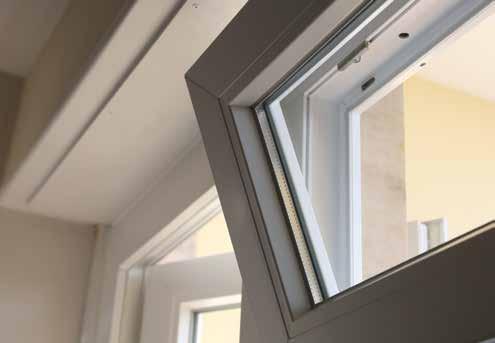
Because of this, the Government launched the “Sustainable Buildings Support Programme” in September for private citizens who own apartments or kinds of housing built by the end of 2006. Developed as part of the Environmental Fund, the initiative has a total budget of €4.5 million EUR; €1.75 million EUR will be distributed in 2020, while the remaining €2.75 million EUR will be awarded in 2021. With technical support coming from the Energy Agency of Portugal (ADENE), this programme has been designed to promote projects that seek to renovate, decarbonise, and increase energy and water efficiency and the use of the circular economy in the country’s buildings.

What are the Portuguese looking for?
Environment and Climate Change Minister João Pedro Matos Fernandes has gone on the record saying that “there is nothing simpler” than the Sustainable Buildings Support Programme and explained how: “You do the work, you send in the bill and proof that you own the house, and then you receive the money.” Fernandes cautioned, of course, that “checks will be done” in order to verify that the projects were actually completed. About two months after having been launched, the Environment Ministry announced that €1 million EUR had already gone out as payments to make buildings more efficient. Since applications went live on the Environmental Fund’s platform on 7 September, 4,234 have been submitted; 890 of these candidates have received payments worth a total of €1.75 million EUR. The programme ended in late December, but the Executive Branch has promised that applications will be reopened in March 2021, with monies coming from the Recovery and Resilience Plan. Each applicant who received a payout received an average of €1,900 EUR. The Portuguese used these monies most often to install photovoltaic panels (50%), heat pumps and solar panels (38%), and energy efficient windows (10%). Fernandes explained that “Portugal lives in ‘energy poverty,’ and many buildings are very far from being meaning fully energy efficient,” arguing that it will be possible to reduce energy spending through this programme. As he stated, “The cheapest energy is that which is not wasted.”
Lack of a long-term vision
Although energy efficiency has been an integral part of the Environmental Fund in addition to new support programmes and funds, there is still no long-term strategy for combatting energy poverty. It’s worth mentioning here that European Recommendation 2020/1563 has already been issued to all member states regarding the implementation of Directive 2019/944, which will come into force on 1 January 2021 and whose Article 29 focuses precisely on energy inefficiencies. According to a statement, environmental association ZERO is of the opinion that the current Sustainable Buildings Support Programme “will surely be insufficient and will very likely fail to help those most vulnerable to energy poverty, given the programme’s lack of monitoring that appropriate financial instruments (grants, subsidised loans) are used and the fact that its funds are given out via reimbursements. The expenses in question are far too costly for the vast majority of those who most need the support.” This programme is, thus, just one support measure for a country that wants to be more energy efficient. But it’s not enough. And it doesn’t even reach everyone. Despite this, it is waking up citizens and families to the importance of their role as promoters of a more circular, more sustainable economy.

Atelier Atelier46 Atelier Atelier
Pritzker no feminino Women win the Pritzker “Dançar cada vez como se fosse a primeira vez”

Uma das sessões da Web Summit, que decorreu no mês de Dezembro em formato virtual, pretendia debater o tema “Alterando a realidade: a próxima onda da arquitectura”. E a mais recente vaga somos todos nós. One of the sessions held during the 2020 Web Summit, which took place virtually in the month of December, debated the topic “Altering reality: the next wave of architecture.” Well, that latest wave is all of us.
À conversa com Marcus Fairs, Editor in chief da Dezeen, estiveram as arquitectas Yvonne Farrell e Shelley McNamara co-fundadoras da Grafton Architects, um atelier de arquitectura internacional com sede em Dublin, Irlanda. Estas poderiam ser mais duas mulheres no mundo da Arquitectura mas merecem o destaque por terem sido, em 2020, as primeiras mulheres a compartilhar o Prémio Pritzker, a maior homenagem na profissão de arquitecto. Questionadas por Marcus Fairs sobre o facto de serem mulheres nesta área e se faz a diferença, Yvonne Farrell responde prontamente que “a arquitectura é um desafio e não é algo baseado no género”. “Não fomos discriminadas por sermos mulheres arquitectas”, disse, mas reconhece, com pesar, que “há mulheres que ainda não têm essa oportunidade”. E como fazem arquitectura? Shelley McNamara usa uma expressão muito curiosa: “Dançar cada vez como se fosse a primeira vez”, fazer, criar sempre com um novo olhar. No processo de concepção de um projecto considera que é importante e enriquecedor compreender os “territórios”, ou seja, “entender as pessoas, a dimensão dos negócios ou as tecnologias” mas também é vital recorrer a “ferramentas de aproximação” e à “co-criação entre vários especialistas” que podem ser arquitectos, designers ou de outras áreas mas que trazem um importante contributo e um ângulo diferente a cada obra. Acrescenta ainda que “temos de ter ética” e “ser responsáveis no uso dos recursos”. Neste ponto Yvonne abre-nos a mente para o todo da arquitectura de hoje e do amanhã. Por um lado, tentam “encontrar o ADN das pessoas (clientes)”; mas, por outro, incluem a “cultura local, a geografia, os materiais locais…”. E vão mais longe, englobam também a Terra: “Este planeta frágil é, em última instância, o nosso cliente final”. Para a dupla de arquitectas a “arquitectura é a nova geografia”, é “espaço livre para os clientes mas também para a comunidade”. Como sublinha Yvonne, “o público em geral percebe que estamos todos ligados e estão mais informados sobre o valor da arquitectura”. Com isso, ganhamos todos!
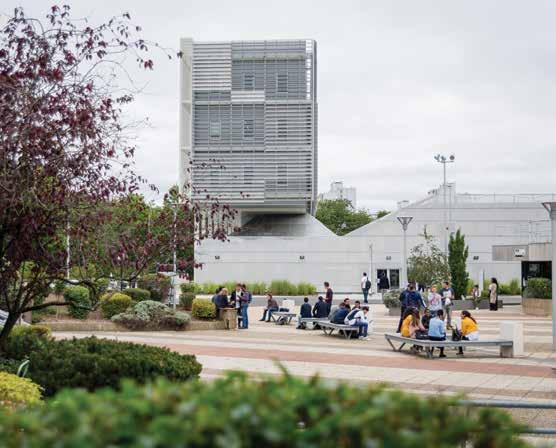
Conversing with Marcus Fairs, editor-in-chief of Dezeen, were architects Yvonne Farrell and Shelley McNamara, co-founders of Grafton
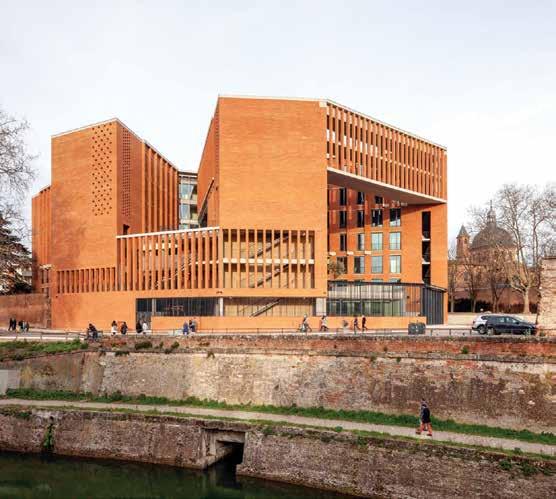

Architects, an international architecture studio headquartered out of Dublin, Ireland. They may be just two more women in the world of architecture, but they deserve special recognition because, in 2020, they were the first women to share the Pritzker Prize, the highest honour in the architectural profession. When asked by Fairs about the fact that they are women in this field and whether it makes a difference, Farrell responded promptly that “architecture is a challenge and not something based on gender.” “We’ve not been discriminated against for being women architects,” she says, but she does laments the fact that “there are women who still this kind of opportunity.” And how do they do architecture? McNamara uses an interesting expression: “To dance each time like it were the first,” to do, to always create with a fresh perspective. While conceptualising a project, she believes that it’s important and enriching to understand the “land,” that is, “to understand the people, the size of the business, or technologies” and that it is also vital to use “approximation tools” and to “co-create with various specialists.” These other specialists could be architects, designers, or from other fields but who can make important contributions and bring a different perspective to each project. She further adds that “we must be ethical” and “responsible in the use of resources.” At this point, Farrell opens our minds to all that architecture is today and can be tomorrow. They seek to both “understand people’s (our clients’) DNA” and include “local culture, geography, and local materials” in each project. But they go further and also encompass the Earth. “This fragile planet is, ultimately, our final customer,” she stresses. For this pair of architects, “architecture is the new geography,” it is “a free space for both customers and the community.” As Farrell points out, “the general public understands that we are all connected, and they are better informed about the value of architecture.” With that, we all win! O público em geral percebe que estamos todos ligados e estão mais informados sobre o valor da arquitectura. The general public understands that we are all connected, and they are better informed about the value of architecture.”
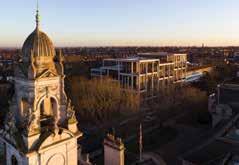



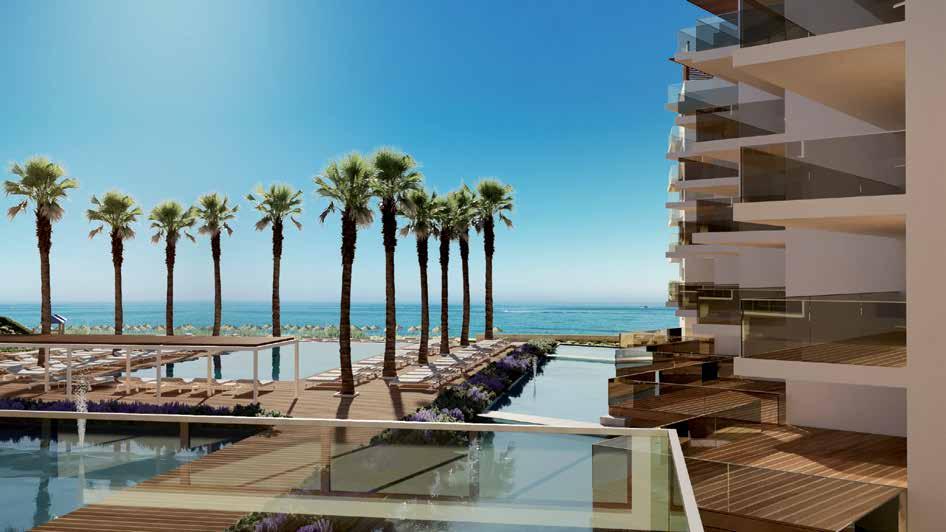
Plumb Line Fio-de-Prumo50 Ventos do Norte North Winds
Porto Oriental Eastern Porto Uma nova centralidade em Campanhã A new hub in Campanhã
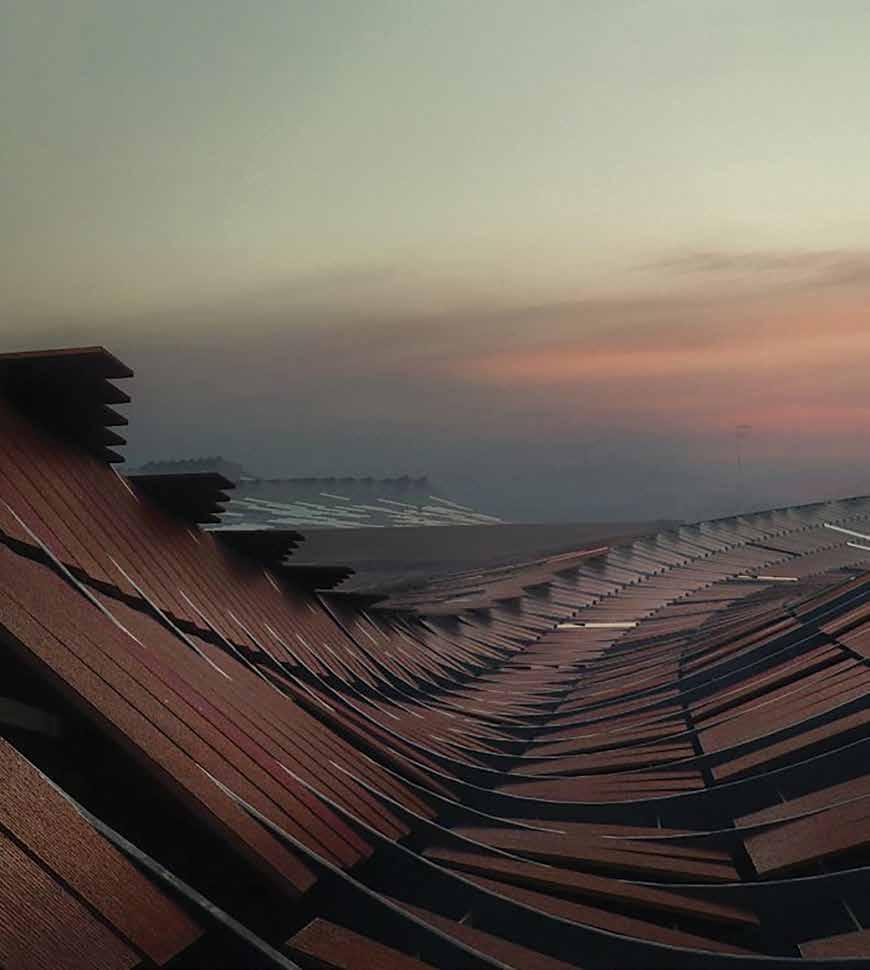
O Terminal Intermodal e o Matadouro são dois dos projectos estruturantes que permitiram a atracção do investimento privado. The Intermodal Terminal and the Slaughter house are two significant projects that have attracted private investment.
Texto Text: Elisabete Soares Fotos Photos: Câmara Municipal do Porto Em 2018 e 2019 a zona Oriental da cidade do Porto deu nas vistas pelo número de operações de aquisições de imóveis concretizadas, superando, em certos períodos, outras zonas que apresentavam grande procura, como era o caso do seu Centro Histórico. O aumento da procura por parte dos investidores de imóveis para reabilitar e terrenos disponíveis, sobretudo na freguesia de Campanhã - onde os preços da habitação eram dos mais baixos, em comparação com as restantes freguesias da Invicta – deve-se ao facto de a zona do Porto Oriental ter sido considerada um eixo estratégico para o crescimento da cidade, sobretudo por parte do executivo camarário liderado por Rui Moreira. O potencial que esta zona da cidade apresenta não está, por isso, alheio ao conjunto de projectos de grandes obras públicas idealizadas para esta zona, como é o caso da requalificação do Matadouro Municipal, da Praça da Corujeira e zona envolvente, do Terminal Intermodal de Campanhã e da zona ribeirinha do Freixo. Cerca de dois a três anos depois do lançamento de alguns destes projectos - e apesar do actual momento estar a ser marcado pelo surto pandémico -, são já visíveis alguns sinais das mudanças que vão alterar o ‘rosto’ desta zona do Porto Oriental. Pedro Baganha, vereador do Urbanismo da Câmara Municipal do Porto, numa apresentação recente sobre as grandes linhas do novo PDM (Plano Director Municipal do Porto), que se encontra em fase final de aprovação, destacava que “onde existe espaço para criar um ‘Porto novo’, para sonhar com uma cidade nova, é precisamente no Porto Oriental, na freguesia de Campanhã. Com escala urbanística e onde se joga o futuro desta cidade”.
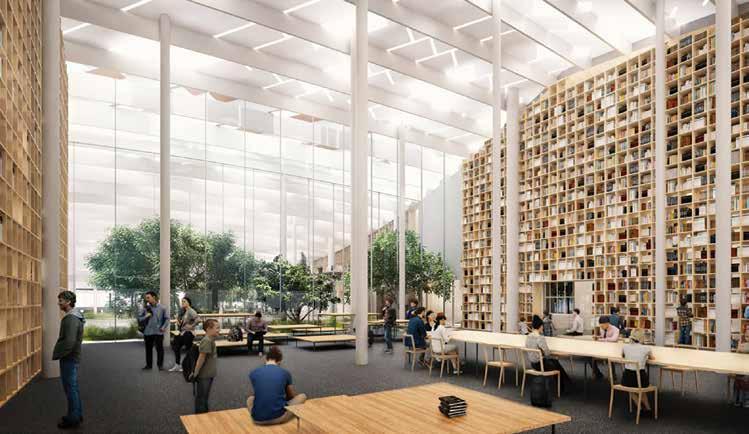
Do Matadouro até à nova Ponte no Freixo
Na verdade, são vários os projectos estruturantes para Campanhã, alguns em construção, outros em fase avançada de promoção. Podemos começar pela nova ponte, à cota baixa, que vai atravessar o Douro, cujo concurso de concepção e construção está para breve, e que permitir novas acessibilidades à zona ribeirinha do Freixo. Esta que é a última zona da marginal do Douro que falta renovar, parece ter agora “uma oportunidade inegável”, nomeadamente através da criação de “um museu da indústria e de um novo pólo cultural”, nos terrenos da antiga central eléc-
trica da EDP, de acordo com o responsável da autarquia. Contudo, o projecto do Matadouro - cujo início das obras está previsto para breve - é considerado a “pedra de toque” para o desenvolvimento desta zona de Campanhã. Trata-se da criação de um novo pólo empresarial, cultural e social, num investimento de 40 milhões de euros, suportados por um investidor privado, a Mota Engil, que ganhou o concurso de concepção, construção e gestão, lançado pela autarquia. Também a Praça da Corujeira está a ser objecto de um projecto para a valorização do seu jardim e de todo o tecido urbano envolvente. Bem como os terrenos das antigas instalações da STCP (Transportes Colectivos do Porto) e de uma fábrica que, neste momento, tem uma ocupação reduzida – que fica em frente ao Matadouro - que a autarquia, no actual PDM, prevê a sua total reconversão. Um dos projectos em fase mais avançada é a construção do Terminal Intermodal de Campanhã, um interface que reúne o comboio e o metro, e contará também com um terminal rodoviário, que se prevê esteja concluído em 2021.

Investidores responderam ao apelo
De acordo com o responsável do urbanismo, a autarquia elaborou um ‘master plano’ para esta zona cidade, com as grandes linhas de intervenção previstas – que precederam a revisão do PDM do Porto – que permitiu que vários investidores tivessem concretizado investimentos, que, neste momento, começam a ser conhecidos. É o caso do projecto da Krest, uma promotora belga liderada por Claude Kandiyoti, que está a desenvolver um projecto de uso misto, junto às estação de Campanhã que será um espaço multifacetado e agregador de dinâmicas ecológica, criativas e colaborativas. “Acredito que a zona da Campanhã é o sítio que responde às necessidades existentes na cidade. É um ‘mix’ entre escritórios e residencial”, destacava o CEO, em Março, numa antevisão dos projectos da cidade presentes no MIPIM 2020, que não se concretizou por causa da pandemia.
In 2018 and 2019, Porto’s Eastern Zone became noteworthy due to the number of real estate-related transactions carried out there, at times surpassing other areas such as the city’s Historic Centre that were experiencing high levels of demand. The increase in demand on behalf of investors for properties they could renovate and unused plots of land (particularly in the civil
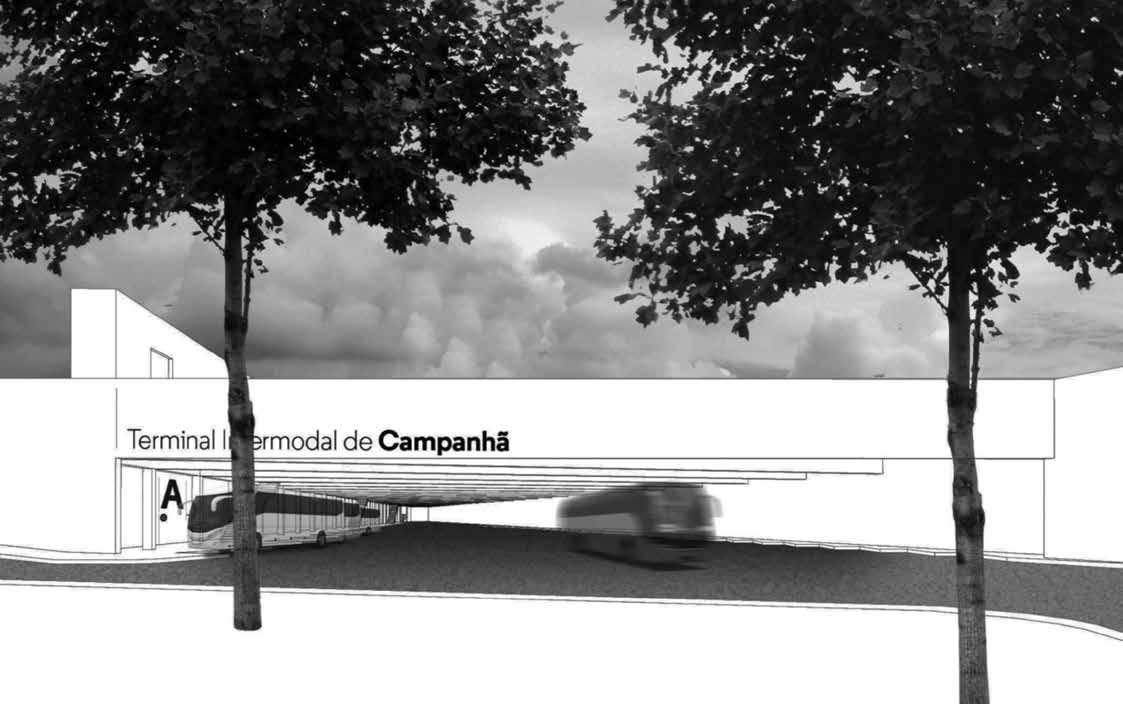

parish of Campanhã, whose housing prices were amongst the lowest in the city) is owed to the fact that Porto’s Eastern Zone has been a cornerstone of the city’s growth strategy, especially for the city council executive led by Rui Moreira. The great civil engineering projects being designed for this part of the city are, thus, ensuring it is used to its highest potential. One such project includes the repurposing of the Municipal Slaughterhouse, Corujeira Square and surrounding area, Campanhã’s Intermodal Terminal, and the Freixo riverside area. About two to three years after some of these projects were launched (and despite the current pandemic), signs of some of the changes that will alter the ‘face’ of this area of Eastern Porto are already visible. Pedro Baganha, a Porto city councilman in charge of urban planning, stated during a recent presentation on the main points of Porto’s Municipal Master Plan (PDM), which is in its final stages of approval, that “Eastern Porto’s Campanhã is clearly where space exists to create a ‘new Porto,’ to dream up a new city. It is just the right size, and this city’s future rests there.”
From the Slaughterhouse to the new Freixo Bridge
There are actually a number of significant structural projects coming to Campanhã. Some are under construction while others are in the late stages of development. Let’s start with the new, low-elevation bridge that will cross the Douro and provide better access to the riverside area of Freixo. The design and construction tender is coming soon. This is the last area of the Douro riverside that remains to be renovated, and it now seems to be “an undeniable opportunity,” namely through the creation of “an industry museum and a new cultural centre” on the grounds of the old EDP power station, according to the councilperson responsible. However, the Slaughterhouse project, construction on which is slated to begin soon, is considered to be the “touchstone” for development in this area of Campanhã. The project will bring a new business, cultural, and social hub to the area for a price tag of €40 million EUR and is being supported by private investor Mota Engil, which won the city’s design, construction, and management tender.

Corujeira Square is also the subject of a project that seeks to enhance its garden and the surrounding urban environs. Other projects include one on the land on which the the former facilities of the Porto Public Transportation Company (STCP)once stood and that of a factory located in front of the Slaughterhouse; this factory currently has reduced occupancy, and the municipality plans to completely renovate it as part of the current PDM. One project that has made the most progress is Campanhã’s Intermodal Terminal, which joins the train station with the metro station. The terminal will also include a bus station and is expected to be finished in 2021.
Investors responded to the call
According to the person in charge of urban planning, the city council drew up a ‘master plan’ for this part of the city, with major projects planned for this area before the broader Porto PDM was revised. This allowed several investors to make investments, which are currently beginning to be made known. Such is the case of the project taken on by Krest, a Belgian developer led by Claude Kandiyoti. Krest is working on a mixed-use project located next to the station of Campanhã. The space will be multifaceted and designed to support ecology, creativity, and collaboration. “I believe that Campanhã is one of the places that is best responding to the city’s current needs. It is a mix of offices and residential buildings,” Krest’s CEO said in March in a preview of the city’s projects that was to be presented at MIPIM 2020, which did not materialise because of the pandemic. Em 2018 e 2019 a zona Oriental da cidade do Porto deu nas vistas pelo número de operações de aquisições de imóveis concretizadas. In 2018 and 2019, Porto’s Eastern Zone became noteworthy due to the number of real estate-related transactions carried out there.”





